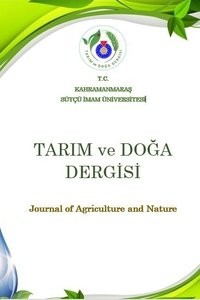Saros Körfezi Gorgon (Anthozoa, Octocorallia, Holaxonia) Topluluklarının Demografik Yapıları
Oktokoral mercan, boy-frekans dağılımı, Ege Denizi, Eunicella, Deniz koruma
Demographic Structure of Gorgonian (Anthozoa, Octocorallia, Holaxonia) Assemblages in the Bay of Saros
Octocoral, size-frequency distribution, Aegean Sea, Eunicella, marine conservation,
___
- Ateş AS, Kocataş A, Yurdabak FE 2005. Decapod (Crustacea) Fauna of Saros Bay (Northeastern Aegean Sea). Turkish Journal of Zoology, 29 (2): 119-124.
- Ballesteros E 2006. Mediterranean coralligenous assemblages: a synthesis of present knowledge. Oceanogr Mar Biol 44: 123-195.
- Cerrano C, Bavestrello G, Bianchi CN, Cattaneo-vietti R, Bava S, Morganti C, Morri C, Picco P, Sara G, Schiaparelli S, Siccardi A, Sponga F 2000. A catastrophic mass-mortality episode of gorgonians and other organisms in the Ligurian Sea (North-western Mediterranean) summer 1999. Ecology Letters, 3: 284-293.
- Coma R, Pola E, Ribes M, Zabala M, 2004. Long-Term Assessment of Temperate Octocoral Mortality Patterns, Protected Vs. Unprotected Areas. Ecological Applications, 14: 1466-1478.
- Gambi MC, Barbieri F 2012. Population Structure of the Gorgonian Eunicella Cavolinii In The “Grotta Azzurra” Cave off Palinuro, after the Mass Mortality Event in 2008. Biol. Mar. Mediterr, 19:174-175.
- Garrabou J, Coma R, Bensoussan N, Bally M, Chevaldonné P, Cigliano M, Diaz D, Harmelin JG, Gambi MC, Kersting DK, Ledoux JB, Lejeusne C, Linares C, Marschal C, Pérez, T, Ribes M, Romano JC, Serrano E, Teixido N, Torrents O, Zabala M, Zuberer F, Cerrano C, 2009. Mass mortality in Northwestern Mediterranean rocky benthic communities: effects of the 2003 heat wave. Global Change Biology, 15: 1090-1103.
- Gili JM, Coma R, 1998. Benthic suspension feeders : their paramount role in littoral marine food webs. Trends in ecology & evolution (Amsterdam), 13: 316-321.
- Gori A, Rossi S, Linares C, Berganzo E, Orejas C, Dale MRT, Gili J-M 2011. Size and spatial structure in deep versus shallow populations of the Mediterranean gorgonian Eunicella singularis (Cap de Creus, northwestern Mediterranean Sea). Marine Biology, 158:1721-1732.
- Gori A, Rossi S, Berganzo E, Pretus JL, Dale MRT, Gili J-M. 2010. Spatial distribution patterns of the gorgonians Eunicella singularis, Paramuricea clavata, and Leptogorgia sarmentosa (Cape of Creus, Northwestern Mediterranean Sea). Marine Biology 158:143-158.
- Gori A, Bramanti L, López-González P, Thoma JN, Gili J-M, Grinyó J, Uceira V, Rossi S 2012. Characterization of the zooxanthellate and azooxanthellate morphotypes of the Mediterranean gorgonian Eunicella singularis. Marine Biology, 159:1485-1496.
- Jones CG, Lawton JH, Shachak M 1994. Organisms as Ecosystem Engineers. Oikos, 69: 373-386.
- Kipson S, Fourt M, Teixidó N, Cebrian E, Casas E, Ballesteros E, Zabala M, Garrabou J, 2011. Rapid Biodiversity Assessment and Monitoring Method for Highly Diverse Benthic Communities: A Case Study of Mediterranean Coralligenous Outcrops. PloS one 6: e27103.
- Kurt G, Ergen Z, Çinar M E 2007. Soft bottom Lumbrineridae (Polychaeta) species in Izmir and Saros Bays (Aegean Sea) Rapp Comm Int Explor Scient Mer Méditerr, 38: 525.
- Linares C, Coma R, Diaz D, Zabala M, Hereu B, Dantart L 2005. Immediate and delayed effects of a mass mortality event on gorgonian population dynamics and benthic community structure in the NW Mediterranean Sea. Marine Ecology Progress Series 305: 127-137.
- Linares C, Coma R, Garrabou J, Díaz D, Zabala M 2008. Size distribution, density and disturbance in two Mediterranean gorgonians: Paramuricea clavata and Eunicella singularis. Journal of Applied Ecology 45: 688-699.
- Linares C, Zabala M, Garrabou J, Coma R, Diaz D, Hereu B, Dantart L 2010. Assessing the impact of diving in coralligenous communities: the usefulness of demographic studies of red gorgonian populations. Scientific Reports of Port-Cros National Park 24: 161-184.
- Munari C, Serafin G, Mistri M 2013. Structure, growth and secondary production of two Tyrrhenian populations of the white gorgonian Eunicella singularis (Esper 1791). Estuarine, Coastal and Shelf Science, 119: 162-166.
- Pazi I 2008. Water mass properties and chemical characteristics in the Saros Gulf, Northeast Aegean Sea (Eastern Mediterranean). Journal of Marine Systems 74: 698-710.
- Sini M, Kipson S, Linares C, Koutsoubas D, Garrabou J 2015. The Yellow Gorgonian Eunicella cavolini: Demography and Disturbance Levels across the Mediterranean Sea. PLoS ONE 10:e0126253.
- Topçu EN, Öztürk B 2016. Reproduction in the Mediterranean endemic gorgonian Spinimuricea klavereni (Anthozoa, Octocorallia, Plexauridae). Invertebrate Biology 135(1): 13-19.
- Topçu EN, Öztürk B 2016. First insights into the demography of the rare gorgonian Spinimuricea klavereni in the Mediterranean Sea. Marine Ecology 37(5): 1154-1160.
- Velimirov B. 1973. Orientation in the sea fan Eunicella cavolinii related to water movement. Helgol Wiss Meeres, 24: 163–173.
- Velimirov B. 1975. Wachstum und altersbestimmung der gorgonie Eunicella cavolinii. Oecologia, 19: 259–1272.
- Weinbauer MG, Velimirov B 1995. Morphological variations in the Mediterranean sea fan Eunicella cavolini (Coelenterata: Gorgonacea) in relation to exposure, colony size and colony region. Bull Mar Sci. 56: 283–295.
- Yurtsever A 2002. Kuzey Ege Denizi’nde bulunan bazı yumuşak mercan türlerinin popülasyon yapısı üzerine araştırmalar. İÜ Fen Bil. Ens.. Deniz Biyolojisi ABD, Yüksek Lisans tezi, 23 s.
- Başlangıç: 1997
- Yayıncı: Kahramanmaraş Sütçü İmam Üniv.
Primula vulgaris Yaprak Ekstraktının Antioksidan ve Sitotoksik Özelliklerinin Değerlendirilmesi
Selim DEMİR, İbrahim TURAN, Rezzan ALİYAZICIOĞLU, Yüksel ALİYAZICIOĞLU
Doğu Akdeniz Bölgesinde Bulunan Sulak Alanlarda Oluşan Toprakların Kil Minerali Özellikleri
Ahu Alev ABACI BAYAN, Kadir YILMAZ
Sosyal Medyanın Tüketicilerin Gıda Ürünleri Satın Alma Davranışına Etkisi
Aşağı Seyhan Ovası Sulama Birliklerinin Kümeleme Analizi İle Karşılaştırılması
Hasan DEĞİRMENCİ, Çağatay TANRIVERDİ, Fırat ARSLAN
Sivas İli Heterocera (Lepidoptera) Faunasına Katkılar
Echinops phaeocephalus (Asteraceae) Türünün Antimikrobiyal ve Antioksidan Aktivitesi
Neşe ERTUGAY, Emine MALKOÇ, Nihal KOCAKAPLAN
Saros Körfezi Gorgon (Anthozoa, Octocorallia, Holaxonia) Topluluklarının Demografik Yapıları
Türkiye Orjinli Yulaf Genotiplerinin Basit Dizi Tekrarları (SSR) Markörleriyle Karakterizasyonu
Ali TEKİN, Erdem ASLAN, Sevgi HEREK, Tevrican DOKUYUCU, Hasan GEZGİNÇ, Halil TEKEREK, Ziya DUMLUPINAR, Aydın AKKAYA
